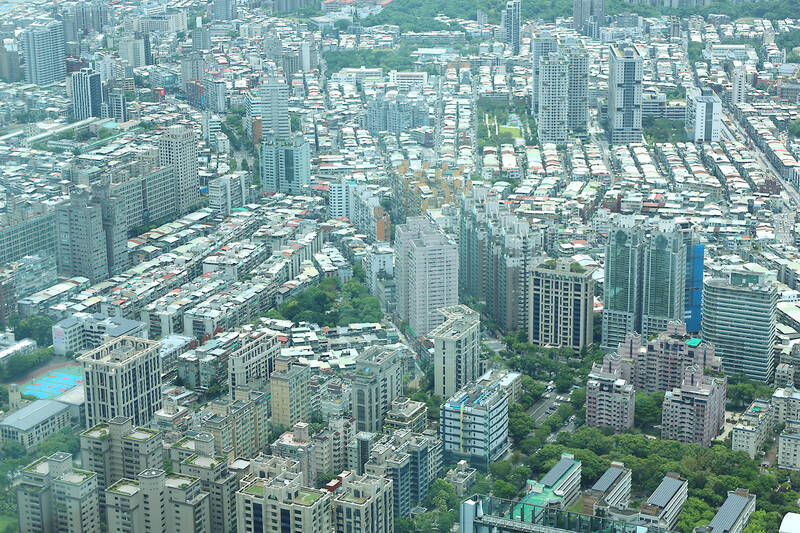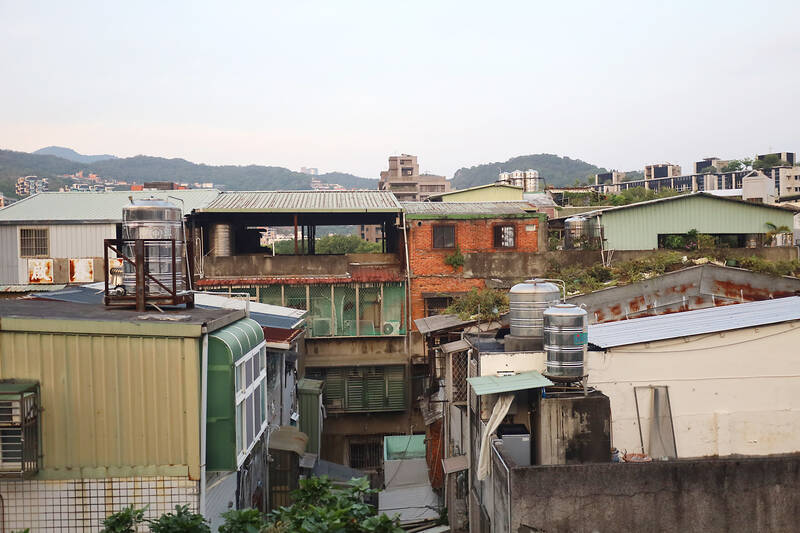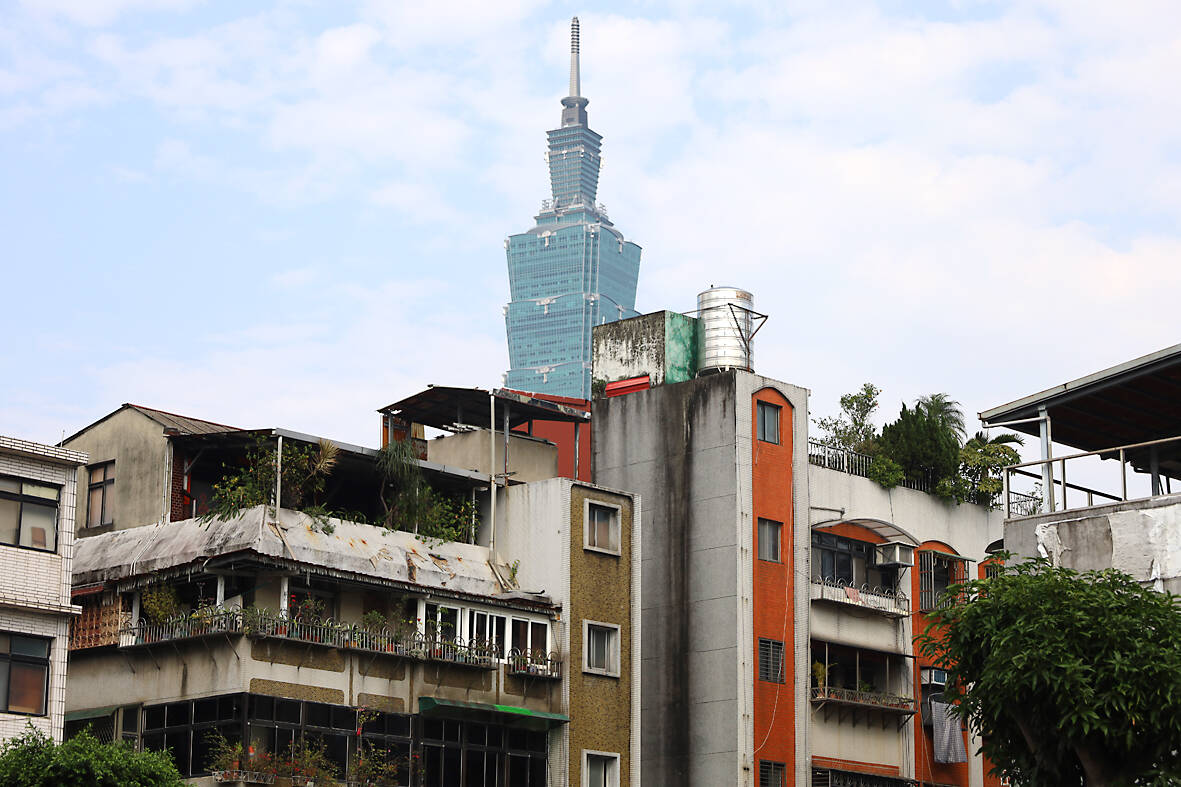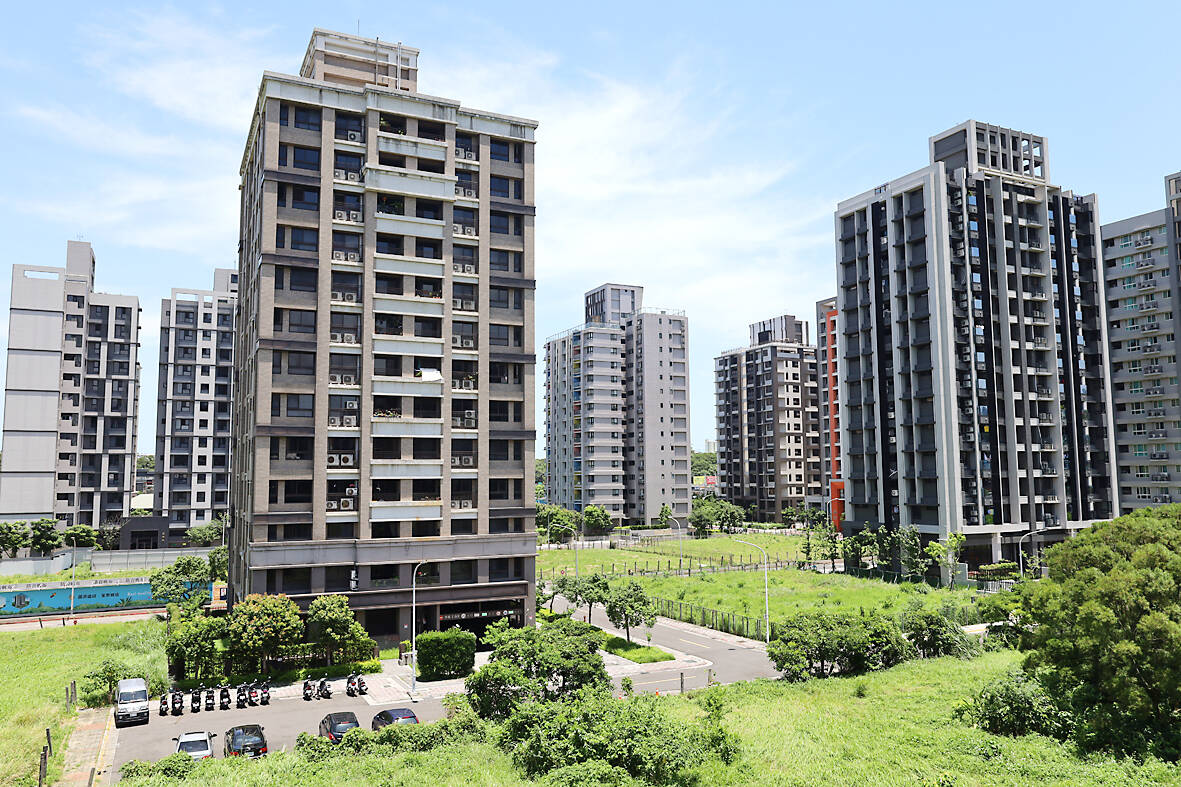From 2004 until 2010, school children around the globe would learn from their geography teachers that the tallest building in the world was in Taipei.
Although construction of what was then called the Taipei World Finance Tower was not without mishap — in 2002, an earthquake caused a crane to fall, crushing vehicles below and causing five fatalities — the completed tower was designed to be both typhoon and earthquake resilient. The latter quality was commented upon by several journalists in the wake of the 7.2 magnitude earthquake that struck Hualien County (花蓮) on April 3.
Not only was Taipei 101 built to last, it was also designed to look good — the repeated segments of its exterior recalling the eaves of an ancient pagoda, or a stalk of bamboo, endower the building a strong sense of place while making it immediately identifiable.

Photo: Thomas Bird, Taipei Times
What is striking, however, some 20 years after first opening its doors, Taipei 101 remains the only supertall structure in the neighborhood, not to mention, the only tall building with any serious aesthetic charm.
The tower’s elevator delivers visitors to the 89th floor observatory, from where an unrivalled vista of Taipei can be enjoyed. The experience remains a “must-do” on many tourists’ bucket list. Yet notwithstanding some “wows” and selfie-stick portraiture, the 360-degree vista reveals a vision of turn-of-the-century utopianism betrayed.
Put simply, Taipei doesn’t reach for the stars, it sprawls.

Photo: Thomas Bird, Taipei Times
VERTICAL VIRTUE
One of the main criticisms aimed at tall cities is that they can be ugly, soulless places. Certainly, we only need look across the strait to see countless examples of this — urban expanses where developers have unsentimentally turned ancient cities into forests of identikit concrete high-rises.
However, much of the People’s Republic of China’s (PRC) hellscape urbanism is the result of unimaginative planners in cahoots with an ill-regulated real estate sector, rather than the fault of the skyscraper per se.

Photo: Thomas Bird, Taipei Times
One only need head south to Hong Kong’s Victoria Harbor to see a skyscraper cluster that is as iconic as any cherished old-world city. Indeed, Hong Kong Island is far more attractive than the bland expanses of Houston and other car-centric cities that blemish the American landscape.
By contrast, the US’s principle vertical metropolis, New York, is a concrete totem of American prowess, and remains one of the most productive and creative cities on the continent, in part, due to the way New Yorkers live.
“Cities are ultimately about the connections among people,” writes Edward Glaeser in Triumph of the City (2011), “but structures […] make those connections easier.”

Photo: Thomas Bird, Taipei Times
New York-born economist Glaeser recognizes that cities are made of people, not buildings, yet also understands that the more intimately people live, the easier it is for them to interact. Put simply, tall, highly-dense cities improve worker productivity by eliminating arduous commutes and by cultivating cooperation. This is because, if you live in a tall building near a vibrant city center, you’ll likely dine out or use shared public spaces like parks. In doing so, your life becomes more social. Ideas are exchanged, business alliances are forged and the wheels of innovation turn.
This doesn’t happen if you live miles away from downtown and spend much of your free time fondling your phone on a bus, as is the case for many Taipei denizens.
Recently I took the 11pm train to Taoyuan International Airport (桃園國際機場) to meet a friend. On the way, I got chatting with a young graphic designer.

Photo: Thomas Bird, Taipei Times
“Where are you heading?” I asked, imagining an overseas trip.
“I’m on my way home, who can afford the rent in Taipei these days?”
The sentiment is not unusual.
Danhai New Town (淡海新市鎮) in New Taipei City’s Tamsui District (淡水區) was, until 15 years ago, largely rural, the domain of fish farms and fields. Nowadays, it is the focus of hot property speculation, despite the fact it is some 26 kilometers from Taipei 101 and the Central Business District in Xinyi (信義區).
The reason people are willing to live over an hour away from their workplace is simple, according to the Tamsui-based real-estate agent Chang Chun-kai (張鈞凱) I spoke with: “The average price in Tamsui is NT$300,000 per ping (坪, 3.3 square meters) whereas in Taipei it’s well over NT$1 million.”
He also told me seven out of 10 Tamsui residents worked in the city.
The view from Taipei 101 alludes to why this is the case. Amidst the occasional office block or modern apartment complex, much of the cityscape is still the domain of old flats stacked five or six stories high — the maximum height for buildings with no elevators. With such a propensity of low-rise, low-grade properties, it is little wonder that the municipality of Taipei is only home to 2.6 million people despite being almost as large as the territory of Hong Kong, which has a population of 7.5 million people.
Taipei’s rustic old quarters might be evocative areas to walk around but they don’t stand close inspection, nor would you want to live in a building where the concrete has cracked, leaky pipes protrude walls, dark and cluttered hallways link dank and crowded rooms rising to rooftops housed in rusting, corrugated iron.
The historical reasons for building such poor housing are myriad. Many point to The Chinese Nationalist Party’s (KMT) belief that it was only squatting in Taiwan, so it didn’t invest too heavily in housing.
What is clear is that shabby, outmoded buildings dominate the valuable land that could be put to far better purposes, either by accommodating Taiwan’s young and talented in affordable high-rises or by providing them with state-of-the-art places to work in.
And, while the status-quo persists, Taipei is paying a huge price in lost worker productivity due to the thousands of daily hours spent shuttling to and from work on buses, trains, scooters or in cars.
TALL IS GREEN
Greater Taipei’s sprawl is not just unsightly, it is also exacerbating the climate crisis, as carbon is belched from vehicles moving people between the city and satellites like Danhai that carpet over precious greenbelt. Skyscrapers would mitigate these emissions as high density would enable people to walk, or make short public transport journeys, to work.
The skyscrapers themselves could also be designed with the environment in mind. Urban planners only need to take a leaf from Singapore’s green handbook to learn of the new concept “biophilic architecture” which the Lion City is pioneering in order to “put nature at the heart of construction.”
Examples of this include the 27-story mixed-use hotel and office skyscraper Oasia Hotel Downtown, which is home to 54 species of plants and trees, 33 of which are found in its sky gardens. The building has a green plot ratio of 1,100 percent, which means the total area of plants on the building can compensate for the lack of greenery on 10 similar-sized sites.
Taiwan already has the knowhow to build big while thinking green. When you leave Taipei 101 you might notice a sign celebrating the building’s recognition from Leadership in Energy and Environmental Design (LEED) as “As the World’s Tallest Green Building” in 2011 and “A World’s Paradigm in Green Habit Management” in 2016, due to its smart energy management control system and other innovative features.
Indeed, a technically advanced and creative city like Taipei should have no difficulties resourcing the talent to build a green high-rise city. The only question is that of political will.

The Democratic Progressive Party (DPP), Chinese Nationalist Party (KMT), and the country’s other political groups dare not offend religious groups, says Chen Lih-ming (陳立民), founder of the Taiwan Anti-Religion Alliance (台灣反宗教者聯盟). “It’s the same in other democracies, of course, but because political struggles in Taiwan are extraordinarily fierce, you’ll see candidates visiting several temples each day ahead of elections. That adds impetus to religion here,” says the retired college lecturer. In Japan’s most recent election, the Liberal Democratic Party lost many votes because of its ties to the Unification Church (“the Moonies”). Chen contrasts the progress made by anti-religion movements in

Taiwan doesn’t have a lot of railways, but its network has plenty of history. The government-owned entity that last year became the Taiwan Railway Corp (TRC) has been operating trains since 1891. During the 1895-1945 period of Japanese rule, the colonial government made huge investments in rail infrastructure. The northern port city of Keelung was connected to Kaohsiung in the south. New lines appeared in Pingtung, Yilan and the Hualien-Taitung region. Railway enthusiasts exploring Taiwan will find plenty to amuse themselves. Taipei will soon gain its second rail-themed museum. Elsewhere there’s a number of endearing branch lines and rolling-stock collections, some

This was not supposed to be an election year. The local media is billing it as the “2025 great recall era” (2025大罷免時代) or the “2025 great recall wave” (2025大罷免潮), with many now just shortening it to “great recall.” As of this writing the number of campaigns that have submitted the requisite one percent of eligible voters signatures in legislative districts is 51 — 35 targeting Chinese Nationalist Party (KMT) caucus lawmakers and 16 targeting Democratic Progressive Party (DPP) lawmakers. The pan-green side has more as they started earlier. Many recall campaigns are billing themselves as “Winter Bluebirds” after the “Bluebird Action”

Feb 24 to March 2 It’s said that the entire nation came to a standstill every time The Scholar Swordsman (雲州大儒俠) appeared on television. Children skipped school, farmers left the fields and workers went home to watch their hero Shih Yen-wen (史艷文) rid the world of evil in the 30-minute daily glove puppetry show. Even those who didn’t speak Hoklo (commonly known as Taiwanese) were hooked. Running from March 2, 1970 until the government banned it in 1974, the show made Shih a household name and breathed new life into the faltering traditional puppetry industry. It wasn’t the first